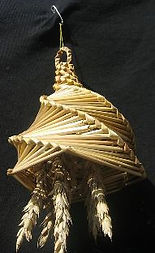
OCCUPATIONS
UNUSUAL JOBS
My other occupation pages have been from the tree’s top ten occupations but what about the slightly more unusual jobs which have either disappeared or become a craft hobby instead of a job. Within the tree we have 2 girls who were Envelope Folders, can you think of a more boring job. We also have 1 Lemon Pulper, 1 Cocoa Dresser 1 Canvasser for Teeth and 1 Mistress in a Hospital (I won’t say what came up on a google search for that because I am sure that’s not what she did).
Here are a few more unusual occupations which I have been able to find out a bit about the work.

Stuff Doffer
A Stuff Doffer was a small boy who used a small roller covered in wire teeth to clean the “stuff” from the bobbins, pins and spindles at the weaving factory. The “stuff” was the remnants of flax used in the making of some clothing.

Straw Plaiter
Straw Plaiting is a method of manufacturing textiles by braiding straw used primarily for straw hats but also used for table mats, light baskets, thatching, creating paper making material or ornamental small surfaces as a straw mosaic.
Thousands of women, especially in the counties of Bedfordshire, Buckinghamshire, Berkshire and Hertfordshire, gained employment in this trade. The area around Luton in Bedfordshire was, since the 17th century, the home of the straw plait industry.
In the early 18th Century, girls were taught to plait at home often from as young as 4 years old. They also often went to Plaiting Schools which were known as “Sore Thumb Schools”. Girls left the schools when they competent enough to work steadily without supervision, after which time they worked at home.
The beautiful examples of the work can be seen here with a Harvest Cross and a Hertfordshire Bell.


Wafer Paper Maker
Wafer Paper is a white sugar free edible slightly translucent paper primarily used in cake making. It has also been called Edible Paper or Rice Paper.
Ad a boy I knew it from eating Macaroons but it can also be used to make edible flowers for cakes as seen here.
For those of you who are budding British Bake Off contestants you can get Wafer Paper from Lakeland.
A Skiver
This is not what you might think, it’s not someone shirking off work.
It was a person using a “Skive”, a cutting tool, used to reduce the thickness of leather.
Soft thin leather from the outside of sheepskin was used in bookbinding. There was a variety of tool shapes but this work is now done by machine.



LOZENGE CUTTER
The lozenge cutter machine was invented by Oliver R Chase in a small drug store in Boston in 1847. The machine was a small table top hand cranked device about the size of a pasta maker, which enabled the user to produce perfect lozenges. Out of this little machine the American Candy (sweet) industry was born.
Oliver Chase was a pharmacist but in the 19th Century it was the pharmacist who used sugar to “help the medicine go down”. Sugar disguised the often bitter and unpleasant taste of medicinal herbs and for some maladies they viewed sugar as medicinal in itself. Chase’ first lozenges were used to sooth the throat or settle the stomach , the lines between candy (sweets) and drugs were very fine in those days.
If you are in the USA and wonder what his first lozenges tasted like then get a tube of
Necco Wafers . These chalky candies seem peculiar today but in the 19th century many lozenges tasted like this. For those in the UK, I am guessing it would be something like the “Love Heart” sweets.